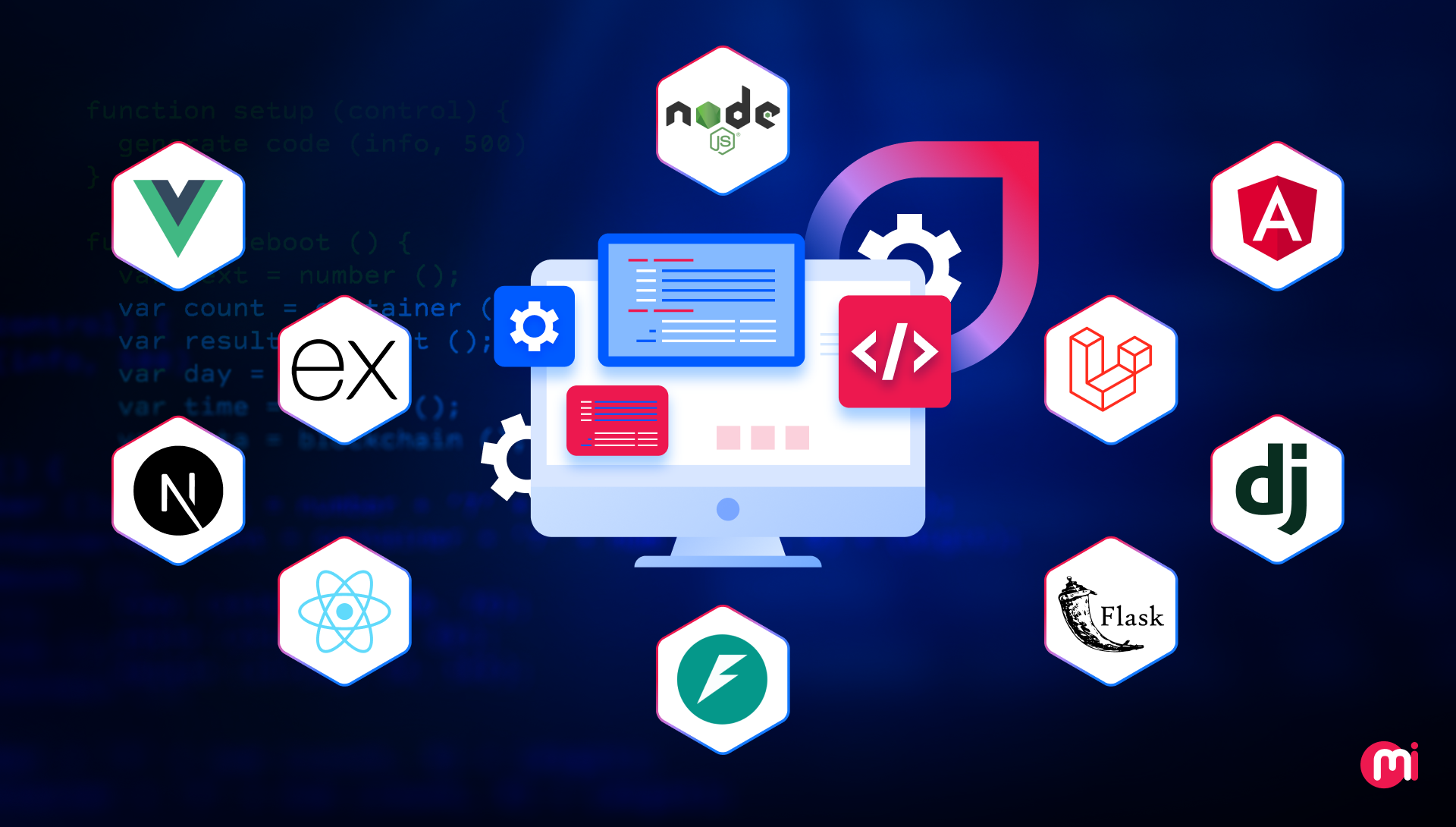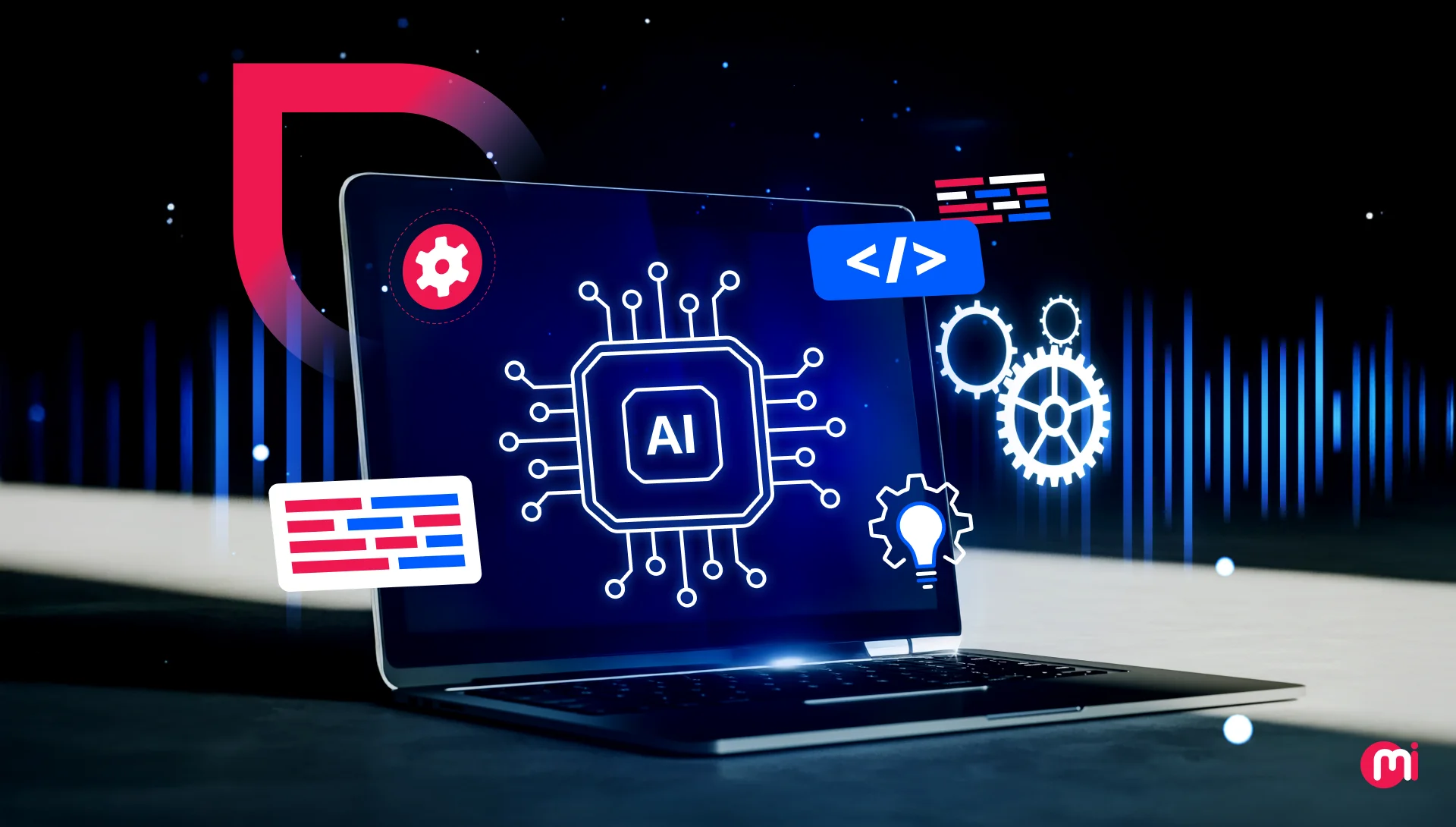Top 15 Web Development Trends to Watch Out for In 2025
- Web
- December 4, 2024
No trend lasts forevermore, and web development trend isn’t an exception either. Therefore, if you’re looking to build a website to take your business online, be in line with the current trends for web development and implement them properly to thrive in this competitive landscape. Thinking how? No worries, we’ve done it for you! This blog is going to walk you through a detailed exploration of the top 15 web development trends in 2025, aiming to enable you to know the trends and build a website that takes your business to the next level.
As time passes by, the user’s needs and preferences change, and so does the web development trend. A trend that works this year might not be that effective next year. In order to outclass around 2 billion websites on the internet, you need to keep yourself abreast with what is in trend, allowing you to build a website that is in alignment with users’ needs.
AI-powered development, PWAs, SPAs, AMPs, Responsive Websites, Mobile-First Website development, and many more are going to be the latest trends in web development in 2025. Right from smooth navigation across channels to AI-powered data-driven offerings and whatnot, the latest web development trends are ready to reshape how users interact with websites.

Above mentioned are just a glance at many web development trends and their benefits, however, there are more we’re going to discuss in this blog. Hence, before you contact a web development company, explore the top 15 web development trends in 2025, and implement them to build a full-fledged website that meets the new-era user’s expectations, letting you thrive in your business. Pairing these trends with professional web research services can help you uncover emerging market needs, ensuring that your website not only looks modern but also aligns with real user data and behaviors.
Latest Web Development Trends to Follow In 2025
After a brief introduction to the basics, let’s explore the future of web development in 2025! It will help you determine how to build a web app, or website, keeping your target audience in mind to thrive in this competitive business landscape.
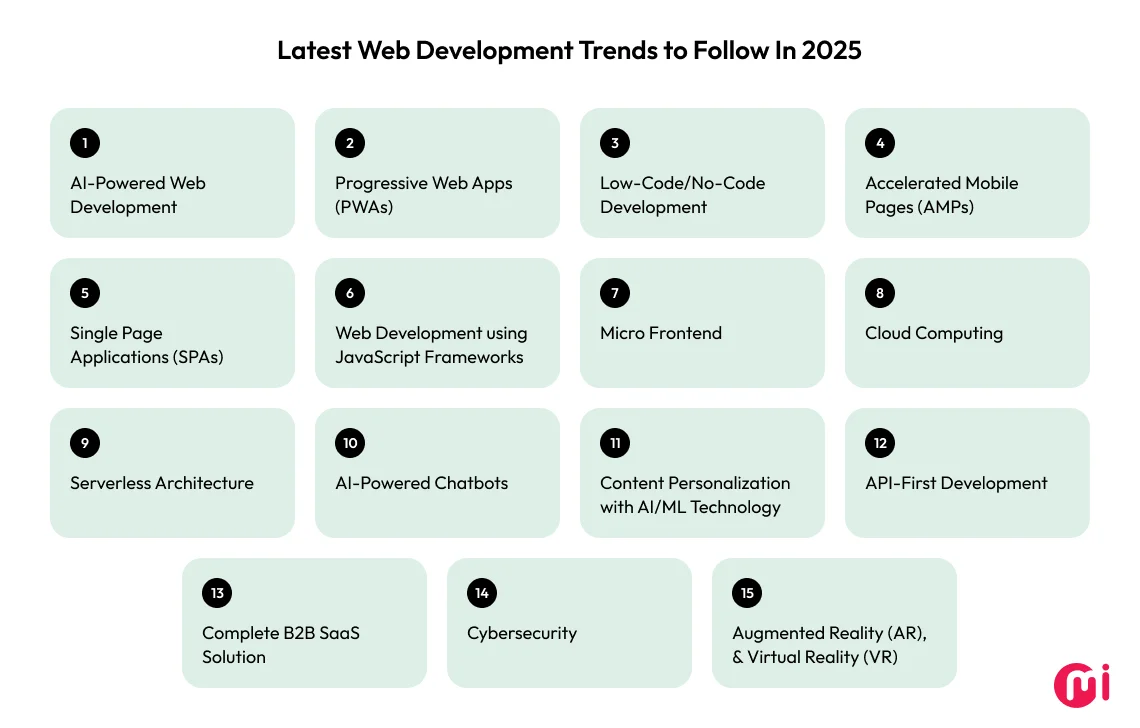
1. AI-Powered Web Development
Artificial intelligence is one of the latest web development technologies, and AI-powered web development is one of the latest trends in web development that is revolutionizing the digital landscape, setting the stage for significant business advancements in 2025.
This cutting-edge approach to web development leverages transformative competencies like automated coding, intelligent website optimization, personalized user experiences, and more.
- Improved Website Optimization: AI optimizes websites by analyzing traffic patterns, pinpointing potential bottlenecks, and promoting automated suggestions for improvements such as faster loading times and SEO improvements.
- Tailored User Experiences: AI enables websites to adapt to the individual user’s real-time needs, providing tailored content, recommendations, and dynamic layouts as per their behavior, preferences, and historical interactions.
- Enhanced Testing and Debugging: AI-driven testing tools conduct predictive analytics, find potential bugs, and fix them to improve the website’s functionality.
- Chatbots and Virtual Assistants: AI-enabled chatbots and virtual assistants are intelligent and competent in handling complex user interactions, providing quick responses, and tailored support for excellent user satisfaction.
Explore how AI in web development fosters automated code generation, testing, and deployment, along with a tailored user experience for your web development project.
2. Progressive Web Apps (PWAs)
Progressive Web Apps (PWAs) are web applications that function as a website and offer native-like app experiences. PWAs are responsive, reliable, faster, and capable of functioning offline or even in poor network availability. Users can install PWAs on devices for a seamless browsing experience across platforms.
You may have used these applications that appear on home screens and taskbars and launch as stand-alone apps without dependency on browsers or other apps. You can use these apps like normal hybrid apps downloaded from app stores. A few PWAs, for example, are Twitter Lite, Instagram, Starbucks, Pinterest, Telegram, Trivago, Tinder, and Spotify.
Here are the favorable changes the PWA technology brings for businesses and users:
- Seamless installation
- Saving device storage and power
- Lessened support and development expenses
- Smooth updates and maintenance
- Faster launch to the market
- More flexible distribution
It is also one of the current trends in web development, however, because of its many traits, Progressive Web Apps are going to be one of the top web development trends in 2025.
3. Low-Code/No-Code Development
Low-code/no-code development is predicted to shape the future of web development in 2025. These approaches to web development come with a variety of pros such as faster development, integration with modern technologies, reduced tech debt, and all these at a reduced expense.
They allow you to get a website built even by a developer with minimalist coding skills. They can do so by using visual interfaces and drag-and-drop tools.
The following are the benefits of Low-Code/No-Code development:
- Faster development cycles
- Integration with modern technologies
- Customization and flexibility
- Reduced tech debt
- Enhanced focus on innovation
- Cost-effectiveness
4. Accelerated Mobile Pages (AMPs)
Conceptualized and brought to life by Google and Twitter together, the concept of AMP stands for Accelerate Mobile Pages. As per the latest stats, there are 1,766,792 live Accelerated Mobile Pages (AMPs) out there, and this is going to be one of the web development trends in 2025. It works quite similarly to PWAs and is a lightweight page with the ability to load quickly on all smart devices in around 0.7–2 seconds as it extensively relies on web caching. It results in better web app performance and an enhanced user experience.
AMPs are optimized pages that feature a convenient and simplified design with basic features compared to full-scope web products. They are also mobile-responsible and have readable content. Because of many attributes like mobile friendliness, SEO optimization, and elevated user experience, AMPs are going to be an excellent web development trend in 2025.
The following are some benefits of building AMPs:
- Mobile-friendliness and enhanced user experience
- Faster website loading time across all smart devices
- Lower bounce rate powered by faster website loading speed and better SEO
- Allows rich data representation and better website performance across browsers
- Eliminates the need for creating sitemaps
5. Single Page Applications (SPAs)
In contrast to traditional web apps, SPAs (Single Page Applications) contain a single page that interacts with users by dynamically updating the current web page with new data from the web server, rather than the default method of loading new pages entirely.
In SPAs, the page refresh never takes place; instead, all the necessary CSS, HTML, and JavaScript code is either retrieved by the browser with a single page load, or the essential resources are dynamically loaded and added to the page depending on necessities in response to the user’s actions.
The preliminary goal of building SPAs is faster transitions that make the website feel like a native application, capable of performing seamlessly. Some top-notch examples of SPAs are Facebook, Twitter, Netflix, Gmail, Trello, and Spotify. Attributed to its various attributes, the SPAs are going to be one of the web development trends in 2025.
Some perks of SPAs include:
- Offline support
- Convenient debugging
- Easy navigation
- Quick page load and reduced bounce rate
- SPAs are perfect for organizations to simplify user navigation and raise profit through quick page loading.
6. Web Development using JavaScript Frameworks
There are many latest web development technologies, however, web development using JavaScript frameworks like React.js, TezJS, Vue.js, Aurelia.js, Meteor.js, and Polymer.js will be one of the latest trends in web development this year. With more than 62.3% of users across the world, JavaScript remained the most-used programming language in 2024 and is expected to reign supreme in 2025, too.
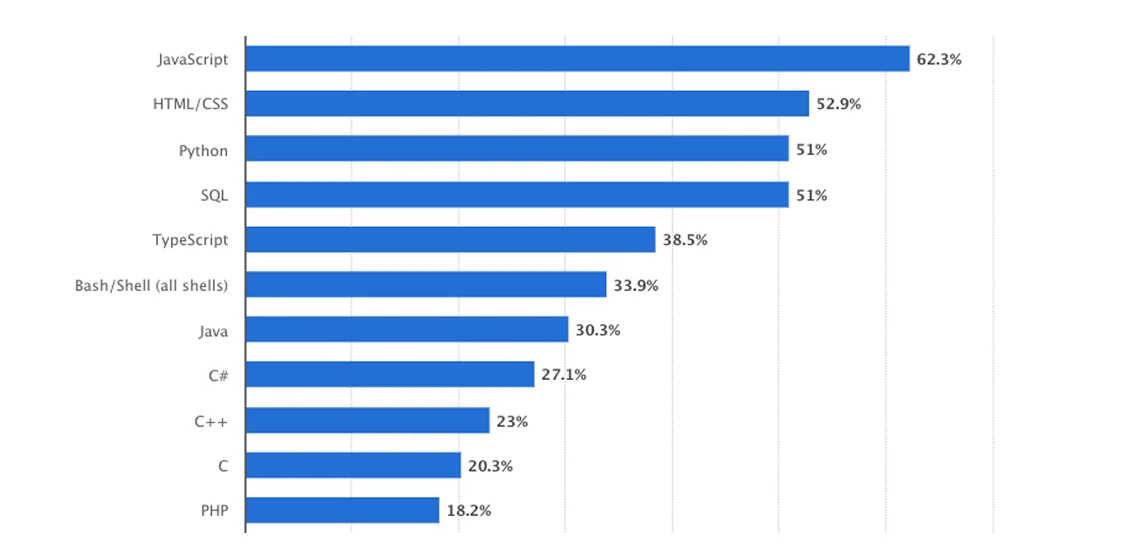
JavaScript is a lightweight, interpreted, and just-in-time compiled programming language for web development. In web development, JavaScript and its frameworks, including React, Angular, Vue, Node, Express, MongoDB, and many others, are the top choices of business leaders and developers.
Statistics say that around 98.6% of websites use JavaScript as a client-side programming language. Previously, developers could make use of JavaScript only for client-side applications, but with the evolution of its frameworks, it can be used for server-side applications as well.
Websites built using JavaScript frameworks are robust, faster, and scalable. Additionally, using these frameworks, you can build resilient, dynamic single-page applications with server-side rendering, benefiting in SEO (Search Engine Optimization) operations.
What makes JavaScript frameworks suitable options for web development?
- A powerful toolkit to build complex and highly interactive web apps
- Reusable components to speed up web app development
- Support for app development with neatly structured codes
- Built-in HTML templating
- The lightweight nature of JavaScript frameworks makes them most suitable for web app development.
7. Micro Frontend
Micro frontend will remain one of the web development trends in 2025. Inspired by the Microservices Architecture for backend management, Micro Frontend Architecture is taking the web development processes to the next level of convenience by dividing the codebase into granular, manageable parts.
Micro Frontend provides developers with excellent conveniences for managing and scaling the source code as needed and delivering a seamless user experience. It enables you to deploy complex, feature-rich, robust web applications and single-page applications effortlessly.
This micro frontend offers the following benefits to web developers:
- Enables teams to scale up by splitting them up into multiple teams working on different web front-end compositions
- Allows adopting different tech stacks
- Enables different teams to work on their code updates without interference from other teams
- Offers edge-level flexibility for web design and development
- Enables developers to build resilient applications
- Embraces DevOps culture to automate code integration and deployment with CI/CD pipelines, leading to faster time-to-market
- Allows developers to scale the front end as needed and a lot more.
8. Cloud Computing
Cloud Computing is among the latest web development technologies businesses use to build highly robust web solutions. With the potential to process data generated at scale, cloud computing enables businesses of all sizes, scales, and industries to surpass their creativity and embrace dynamic working methods. In this remote working age, the adoption rate of cloud technology has surged extensively. According to Statista, the public cloud computing market is estimated to reach $824 billion in 2025.
Public Cloud Services End-User Spending Worldwide From 2017 To 2024
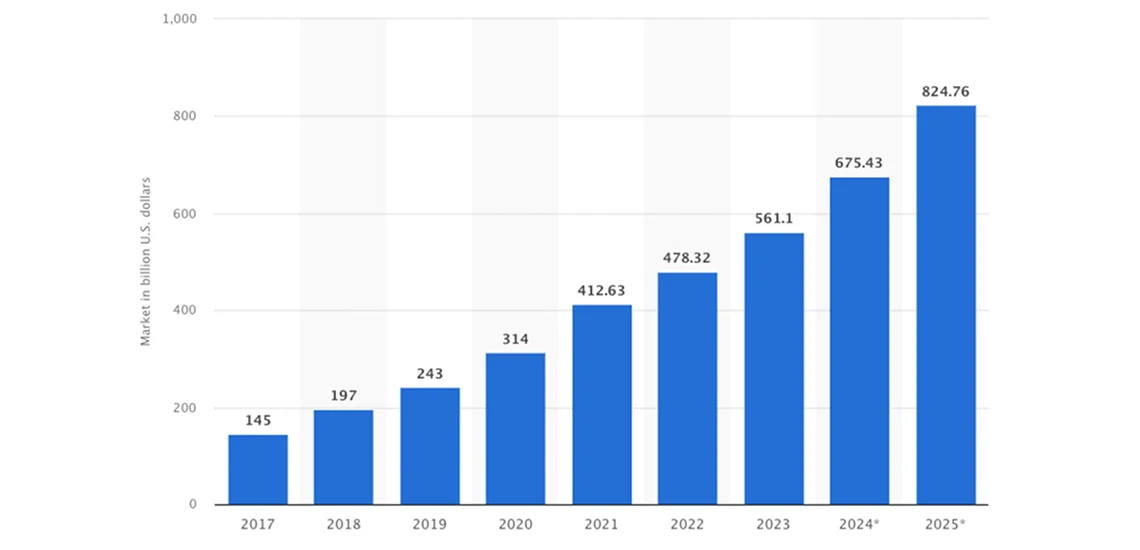
In short, the versatile nature of cloud technology makes it the ultimate choice for organizations for their mission-critical web development, making it one of the top web development trends in 2025.
Following are the offerings of cloud computing for web development:
- It provides immense flexibility and scalability with its pay-as-you-go model
- It offers robust data security
- The pay-as-you-go cloud computing model allows businesses to save money with proper cloud computing resource management
- Allows the storage of data in data centers located across regions and availability zones, ensuring effective disaster management by allowing
- Offers better accessibility to cloud data by enabling users to access their data using any device with internet connectivity
- Using cloud computing services, users can seamlessly deploy, monitor, and manage cloud resources on demand
- By bringing the cloud computing and DevOps teams together, businesses can break web development team silos and speed up development.
9. Serverless Architecture
Being one of the rapidly growing domains, the web documented a massive increase in the popularity of serverless architecture. Right from global access points for easy handling of users, and automated scalability of resources to meeting scaling requirements at minimized cost, serverless computing ensures you get these all. However it’s one of the current trends in web development, it is going to be one of the top web development trends in 2025.
According to the report by Flexera, multi-cloud has experienced a significant increase from 87% last year to 89% this year. It shows the state of cloud architecture and how it is going to be a significant web development trend in 2025.
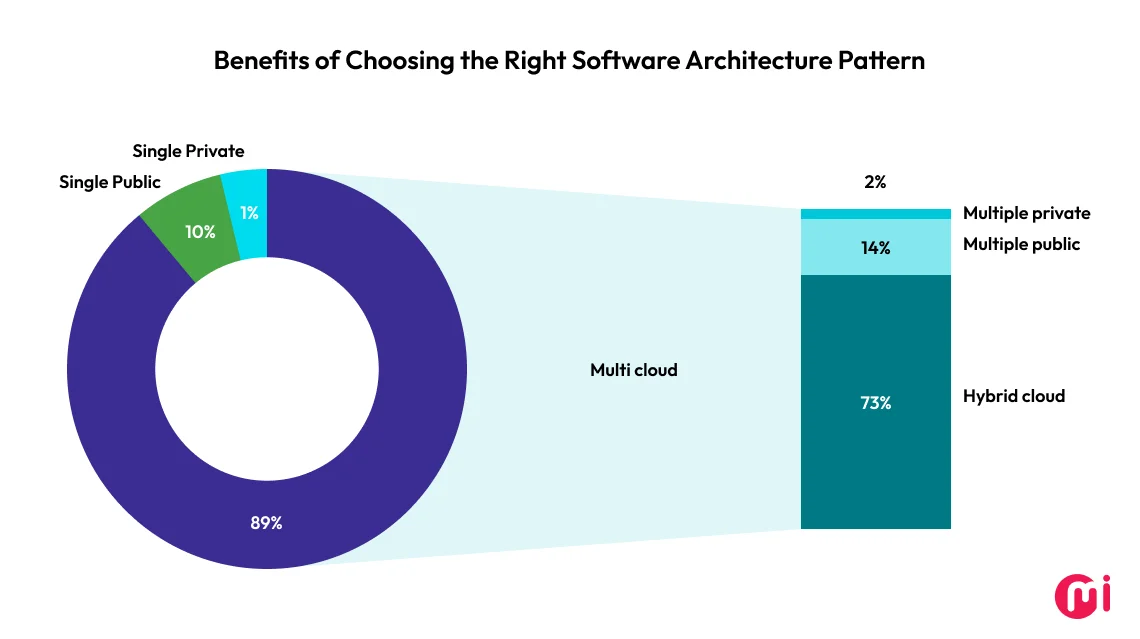
In serverless development, web developers develop and run web apps without considering servers. Cloud providers support these apps even if they still run on servers. Microsoft Azure, Google Cloud, and Amazon Web Services (AWS) are among the top serverless computing service providers.
Serverless computing boasts some exciting benefits:
- Affordability
- Quicker time-to-market
- Convenient deployment
- Improved scalability
- Lowered latency
- Scheduled maintenance
- Cost-effectiveness
10. AI-Powered Chatbots
Attributed to its various pros like uninterrupted assistance around the clock, the AI-enabled chatbots will remain one of the top web development trends in 2025. Providing 24/7 proactive user support, the chatbot has been in the web development trend for years. AI-powered chatbots like Replica and ChatGPT have created a great impact across industries.
The impact is evident as the global chatbot market size is expected to grow to $6.96 billion by 2034 at a CAGR of 19.29% during the forecast period (2023-2034).
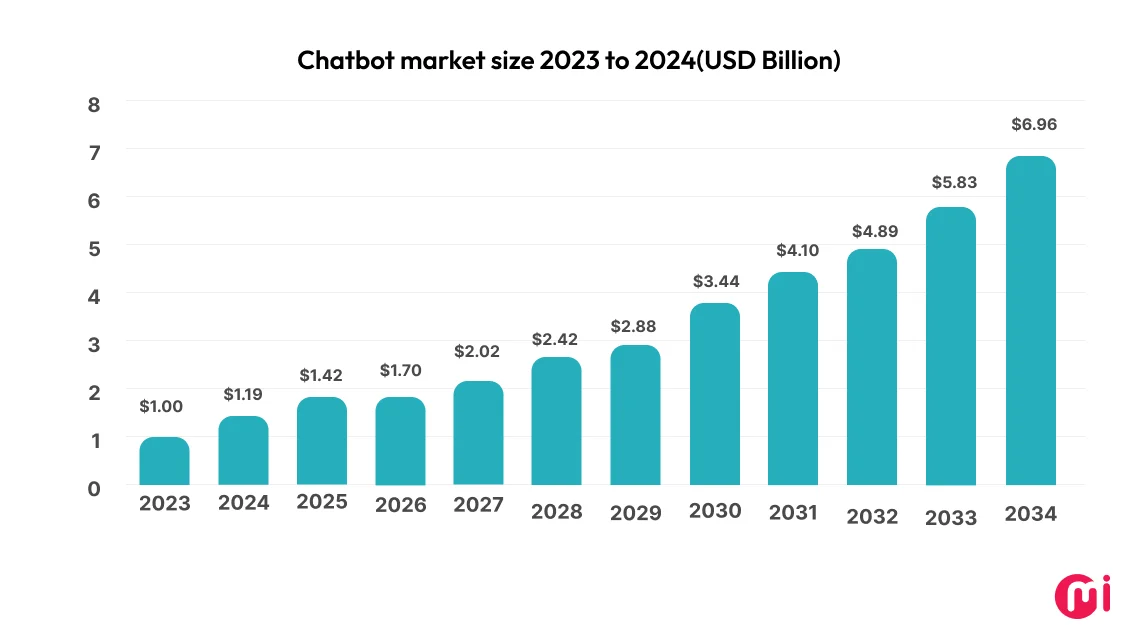
In 2025 and later, this trend is expected to become even more versatile in fulfilling the requirements of matching user behaviors by using natural language processing, machine learning, and data retrieval methods.
Apart from helping organizations speed up their operation with text or voice chats, AI-powered chatbots also enhance the client experience with their 24/7 proactive client support. They find and provide information, fix issues, promptly reply to queries, and, above all, offer an excellent digital experience.
Following are a few benefits offered by AI-powered chatbots:
- Improved customer engagement with business
- Enhanced customer service satisfaction
- Increased lead generation, thus, business conversation
- Ample time-saving for customer service executives
- Reduced customer service costs
- Narrowed-down consumer insights to help you create effective business marketing strategies and make better decisions.
11. Content Personalization with AI/ML Technology
Although AI/ML aren’t that new technologies in web development, they are still used increasingly just for their immense offerings. A user, no matter whichever platform they use, wants the content presented there to be curated as per their interests. As per the Google report, around 90% of leading digital marketers agree that personalized user experience contributes to business profitability. Therefore, content personalization with AI/ML will be one of the latest trends in web development in 2025.
As per the latest content personalization stats 2024 report:
- 71% of the customers expect the content to be delivered in a completely personalized state.
- An average of 3 in 5 marketers consider content to be the most used and useful format for personalization.
- Almost 9 in 10 industry professionals agree that customers expect tailored content.
- Around 66% of customers consider content that isn’t tailored to their specific needs to keep them from deciding to purchase.
Content personalization with AI/ML in web development refers to customizing web experiences, products, and services to individual users’ needs, preferences, behaviors, and interactions. It helps in many ways like recommending products, optimizing layouts, and delivering targeted content to users. It enhances the user experience, boosts conversions, and accelerates business profitability.
So, using AI/ML for content personalization in web development is one of the web development trends in 2025.
What is Content Personalization?
Content personalization is the process of showcasing relevant content to specific audiences or individuals on web pages, email, and other forms of content as per their interest using machine learning algorithms. It is also known as AI-driven predictive content personalization.
AI and ML developers use machine learning algorithms to process incoming data at scale to detect user behaviors and patterns and extract data to deliver content personalization. Just the way Netflix, Spotify, YouTube, Airbnb, and many other apps curate content as per their users’ interests.
What are the benefits of content personalization with AI/ML technology?
- You get real-time analytics to understand users’ behavior on your site, such as their view time, navigation path, sections where they’ve spent more time, etc.
- Enables you to do A/B testing to check recommendations that work well on users
- The audience gets more relevant recommendations, which makes them visit your site often and encourages them to buy, increasing your conversion rate.
12. API-First Development
Similar to many others, API-first development will remain among top web development trends in 2025. As businesses strive to extend their reach to a wider pool of audience through various platforms—websites, mobile apps, Smart TVs, IoT devices, voice assistants, etc.—they need consistent and scalable access to data and services. API-first development enables developers to develop robust, reusable APIs for different apps’ front end. It ensures a consistent user experience across platforms.
APIs tend to serve as the bridge among various client apps and make them convenient to maintain and update throughout the channels without affecting the user experience.
According to Postman’s State of the API report, 71% of respondents followed the API-first approach in 2024, evidencing its usability and popularity in web development.
API-first development approach lowers development expenses and boosts delivery speed. Furthermore, this method permits new websites to become content delivery sources. You can access a CMS created in this method from browsers and smart kiosks or cars.
Therefore, the API-first website development approach is going to be one of the web development trends in 2025, specifically for eCommerce, supply chain businesses, and enterprises, like Netflix, Etsy, and many others.
Some notable perks of API-first development are:
- Enhanced adaptability
- Quicker time-to-market
- Lessened development expense
- Enhanced client experience
13. Complete B2B SaaS Solution
Convenience is all every business needs in this fast-paced digital world where every fraction of a second—a set of data—is generated. Therefore, to get convenience in managing data—being gathered from multiple sources, including websites, mobile apps, and many others—businesses are integrating their digital solutions with one software to make multiple applications talk to each other.
Integrating third-party APIs with your web application can make it possible and help you create a complete B2B SaaS solution. When connecting multiple SaaS solutions, this solution is known as B2B SaaS Integration, which demands support from Cloud and SaaS integration experts to make it a smooth process.
Why do businesses need a complete B2B SaaS Solution?
- Offers efficiency
- Unlock SaaS ecosystem automation
- Easily scale web processes and company operations
- Ensure effective employee-customer services
- Enforce transparency
14. Cybersecurity
Cybersecurity is one of the latest technology in web development using which businesses can make the most out of their initiatives. With over 600 million cyber attacks taking place each day worldwide, cybersecurity will be one of the web development trends in 2025. Businesses will prioritize developing robust security measures for their websites and apps, intending to address these challenges proactively.
Employing advanced encryption protocols will be efficient in securing users’ data while multi-factor authentication will strengthen access control, making it almost impossible for unauthorized users to attempt data breaches. Furthermore, using threat detection systems, businesses can ensure real-time identification and reduction of security threats.
Strict global regulations like GDPR and CCPA will also drive the growing emphasis on the protection of user data and privacy. Besides, securing APIs and implementing zero-trust architectures will play a significant role in safeguarding web apps in the interconnected digital landscape.
The following are the most important benefits of implementing cybersecurity in web development:
- Complete data protection
- Optimal compliance assurance
- Protection to reputation
- Prevention from injection attacks
- Security coding
- Uninterrupted monitoring
- Optimized productivity
15. Augmented Reality (AR), and Virtual Reality (VR)
Aren’t that new technologies in web development, however, AI/VR are frequently used for yielding high-performance web solutions. Among other web development trends, Augmented Reality (AR) and Virtual Reality (VR )are gaining popularity with their unique proposals in web development. AR brings a unique approach for users to explore and interact with the website and its elements like they are part of the real world.
In short, by utilizing AR, web developers can create immersive experiences by blending the physical and digital worlds. It takes the help of smart gadgets, like smartphones, tablets, AR glasses/headsets, etc., to unlock crucial web features like real-time interaction with virtual and real worlds and overlay information about the product you want.
AR also needs the support of computer vision functionality and big data to identify the object and fetch the information to overlay on the real-world surface with the help of the application.
When it comes to using AR in web and mobile app development, retail & e-commerce, real estate, gaming, and supply chain industries reap the most benefits.
As per the Statista survey, the number of users in Augmented Reality (AR)-based software is estimated to reach 3.7 billion by 2029.
Now, let’s have a look at the benefits provided by AR/VR:
- Enhanced user interactions
- Overlaid information in a brief and structured way, enabling users to grasp information without much cognition load
- Increased user shopping and management experience, thus, enhancing loyalty
- Reduced product return rates
- Unlocked next-level personalization
The above-mentioned benefits are the reasons why IKEA, NIKE, Lenskart, and many other top brands have used AR for their web and mobile app development.

MindInventory: The Key to Exceptional Web Development
With 100+ dexterous web developers with an average of 6+ years of industry experience, we, at MindInventory, are a client-centric web development company providing comprehensive web development services to businesses worldwide. We ensure being abreast of the current web development trends and deliver high-end solutions that match your extensive business needs.
Aiming to make travel more accessible, we created a Flight Reservation Platform to enhance the flyer’s experience. The solution experienced a 24% increase in flight bookings, a 72.5% boost in user assistance, and a 55.4% increase in user-friendliness, ensuring unmatched experiences for users.
Collaborating with KFC, we developed a Restaurant PoS System, an online ordering system to elevate kitchen workflows and customer experience. The solution experienced 10M+ downloads with 95% PoS system reliability, delivering an exceptional user experience.
If you have a web development project and you need the right solution, getting connected with our experts could be the way to go. Be it web design, development, or upgrading an existing website, we’re more than happy to take accountability to deliver the highest quality results for businesses.
FAQs About Web Development Trends
By the year 2025, web development will be dominated by AI-driven tools, promoting faster, more intuitive design and coding. Serverless architecture and Progressive Web Apps (PWAs) will get into the mainstream, elevating performance and scalability. Furthermore, AR/VR will be offering an immersive experience, thereby defining the users interact with applications and websites.
Developers use a range of languages for web development, including HTML, CSS, Golang, PHP, Python, and JavaScript to handle the frontend and backend aspects of the website.
With the technological evolution and changing requirements of web consumers, web development is also evolving. There was a time when websites were created only for the digital presence, but now it is more than that and getting more user-centric. From user research intent and UX research and strategy creation to UI designing, industry-leading web technology selection for web development, and many other ways web development is changing.
The time to develop a web app, or website depends entirely upon your business requirements such as features, functionality, and complexity of the project. Besides, the experience, expertise, and location of the developer can differ in the cost of web development.





